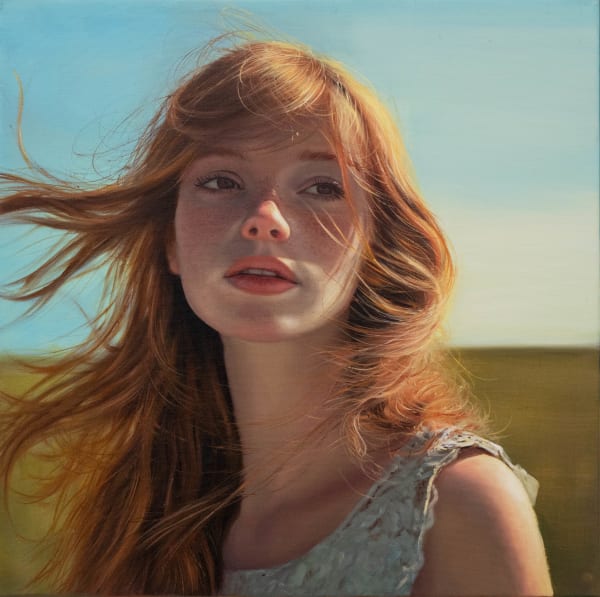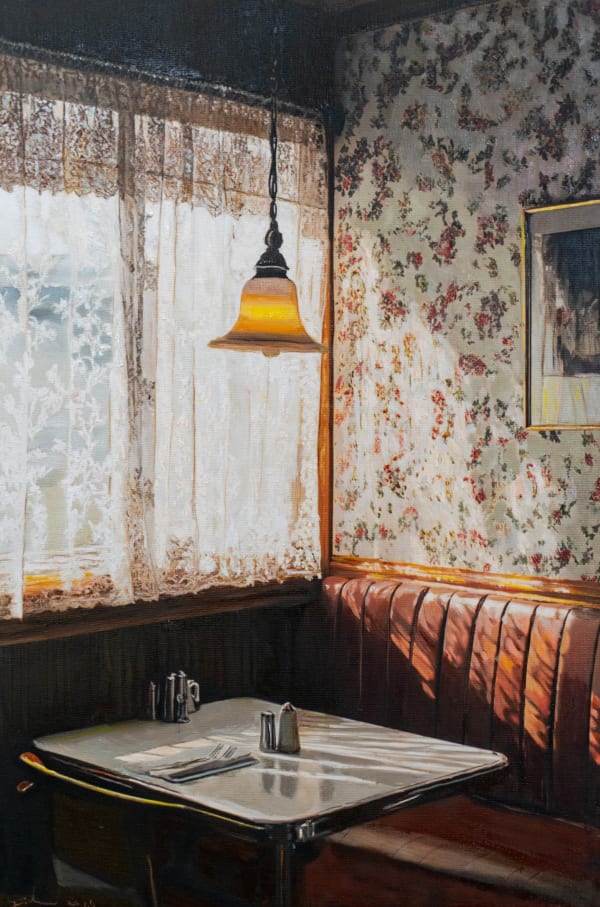Yigal Ozeri: Americana: 251 West 19th Street
Yigal Ozeri: Americana
Ethan Cohen Gallery | 251 West 19th Street, New York, NY
October 23 – December 20, 2025
Opening: November 13, 6 - 8 pm
New York—Ethan Cohen Gallery is pleased to present Yigal Ozeri: Americana, taking place at 251 West 19th Street. Americana is accompanied by a second exhibition by Yigal Ozeri, titled The Art World, which will takes place at Ethan Cohen Gallery's 17th Street location.
Photorealism and Realism are two genres separated by a common language, that of figuration. Yigal Ozeri’s work sets out to eke from both a fusion greater than the sum of its parts. To grasp the ambition of his undertaking one must remember that photorealism emerged in the late 1960s and 1970s as a pursuit of fidelity to the photographic image rather than the subject depicted. Indeed, the photograph was the depicted subject to be reproduced exactly in painting down to the minutiae of detail. As such, the practice celebrated its shortcomings: the flat two-dimensionality, the unbreakable frame of the captured nanosecond, the momentaneous instant of time and light.
Ozeri sets out to dissolve the limits of photorealism in order to deepen our relationship with the portrait or landscape being reproduced. His icon is the human rather than the photograph. He reinfuses depth and perspective—facets deliberately eschewed by the genre’s practitioners as they stay narrowly true to the exposed glimpse. His brush strives to revitalize the natural subject, palpate it back to breath, make it psychologically tactile and three-dimensional. In effect, liberate it from the confines of the frozen image. This is heresy to the genre’s purists. And so to call Ozeri a photorealist is, strictly speaking, a misnomer. Certainly, he was introduced to the art world as a member in good standing of the photorealist school by Louis K. Meisel who coined the term and whose gallery pioneered its top exponents like Chuck Close and Richard Estes. Ozeri’s work toured the world with theirs in museums and group shows. But his humanist preoccupations, in effect his moral esthetic, drove him to a wider horizon.
David Hockney premised his celebrated Polaroid collages of the 1980s on the argument that a photographic image, being a creature of the instant, inherently lacked the crucial dimension of time—in contrast to traditional genres such as painting and sculpture which were composed and executed over time. The subject matter and the artist’s eye simultaneously absorbed the evanescence of light over time. Even the perspective of distance subtly evolved under observation over time. This, after all, is a crucial element of the real as experienced by our species. Hockney experimented with reintroducing into photography the ineffable stigmata of time by collaging images of the same vista captured at different hours. Mutatis mutandis photorealism by its nature lacks the element of time, of felt time, and thereby lacks a crucial dimension of reality and true realism. Ozeri’s paintings strive to bring photorealism closer to that reality. In their search for the felt real, the more inwardly human expressed in outer forms, they borrow visual poetics from romanticism, radiance from the Pre-Raphaelites, and a kind of sensory piety from sacred images. He restores the songlines of time and the universe to the ceremony of seeing.
The first of Yigal Ozeri’s two-part show at the Ethan Cohen Gallery, features 18 paintings and is the smaller of the two. Titled Americana it offers a deceptively more intimate and self-revealing experience. Here we witness a cumulative meditation on female beauty bathed in ethereal otherworldly light. This is the other world of America seen by a yearner from a far country who came to inhabit the place of wonder, its sky a statement of otherness, its women creatures of unattainable light, often cowgirl- hatted and heartland complexioned. If we are witnessing the much-maligned male gaze then the gaze partakes of sky-worship, planetary light and visualized elegies on the sublime. In the ‘Untitled’ series, just such a dreamscape is proposed, a dream of landscape continuous to the American dream girl, indeed the landscape’s own dream. A wholistic vision, projected by divinities in dream form as the Hindu myth of Vishnu has it - he dreamed us entire with the cosmos.
In the painting Afternoon Truck Stop we find that America’s empyrean heartland comes with intrinsic furnishing - girl in denim shorts and tank top sitting on a Ford truck exactly as pale blue as her garb. As blue as the sky in previous paintings but not in this one. Here the celestial blue has faded away westward where the promise of America perennially calls. In view is not the land of cities and power and wealth but the original myth of a vast new continent open to narratives, beauty arising in its vastness and awaiting awakening. Hence the portrait “Patiently Waiting’, a cowgirl at a table in a low-lit bar eyeing us sidewise with interest. We are the new arrivals. Strangers. But isn’t the entire outside world? Yet she, America’s invitation, is scarcely suspicious. Will we keep faith with her solicitude and patience towards strangers, the artist seems to ask us and no doubt asked himself. This bounty and beauty asks for honor in return for such acceptance. And so the artist interrogates himself, along with the viewer, are we worthy of this dreamscape, so freely given? This then is the intimate self-questioning hidden in the paintings. Along the gallery walls, they slowly lose portraiture one by one and become desertscapes with late sun, metaphorically the purest promise of the American horizon, its time and light and hope.
The second exhibition titled ‘The Art World’ offers a numerous extravaganza of portraits depicting figures in the art world, some famous but many not. Many in black and white. Sometimes we see the artist in self-portrait. Throughout the show, we are essentially eavesdropping on Ozeri’s perceptual dance with the living heritage, the individuals portrayed, their place in the art pantheon, and the artist’s own. Abramovic, Warhol, Kusama, Richter, Botero, Ai Weiwei and the like, set the frame of iconic historicity. They are society’s canonized, their images incessantly over-familiar, elevated beyond their work to brand ubiquity. Such is the weight of fame pressing on their work. How clearly can we judge their achievement, how freely can they create, these immortals of an era? How long will their prominence endure? As Warhol showed, the frozen moment of fame can outlast the work.
Once again, Ozeri is playing with time - turning photographs into paintings and adding the images to a more durable tradition in a juxtaposition where contemporary celebrity and the judgment of the ages compete for authority. But before that transmutation comes the choice of the initial picture. In some, the artist has clearly intervened between the two, marking an overt comment. In resplendently bright colors, Louise Bourgeois is being mauled by enlarged details, creatures, from her own art. Ai Weiwei sits back on a grey brick wall in pale blue T-shirt, a passport hanging from between his teeth. Here’s a man trapped in border-crossings of identity, besieged by the demands of state affiliation and persecution. Ozeri elaborates on a black-and-white image of Jeff Koons clad in a glamorous suit against background details of his work and his signature in outsize pink zigzag. Here we have Koons not so much as artist but as a powerful CEO of his brand.
Then there are the purely individualist old-fashioned facial portraits, Richter and Ai Weiwei for example. These refer us back to a time of psychological portraiture beginning with the Renaissance when the highest expression of the painter’s art was to reveal the ‘soul’ or deepest character through the outward features. It was an answer to the universal question - what sort of a person is he or she? The practice, essentially tied to realism, slowly lost its purchase with the advent of abstraction and beyond, the fading of humanism and the artist’s perspicacity as a sine qua non. Ai Weiwei’s face in black and white close-up, fingers on cheek, illustrates the psychological genre with moody precision. Ai Weiwei in tandem with Ethan Cohen, Ozeri’s gallerist and the first to introduce Chinese contemporary art to the outside world including Weiwei, is a study of the artist-gallerist’s relationship, one encompassing decades.
The female portraits often, though not always, embody beauty. They address the role of beauty in art, the question of consensus, the art world’s changing notions of the beautiful. It wasn’t until the emergence of photography that the artist’s model acquired an independent presence, a separate visual narrative, beyond the artist’s frame. The ‘muse’ developed a life of her own, indeed a respectable genre and tradition of her own down the years. Muses are now, manifestly, a registered part of the art community. Ozeri’s paintings of photographs of artists’ models brings the genre full circle. His inclusion of Olya portraits, and Lara Kamhi, occupy that tradition of beauty-as-random qualification for art world (and fashion) fame - except that Kamhi is simply Ethan Cohen’s gallery director and artist in her own right. Once included, the category inevitably serves to question itself when juxtaposed with Yayoi Kusama or Louise Bourgeois. Or even the men. Are they also beautiful? Where does the definition find its limit?
Individual portrayals aside, The Art World show envelops the consciousness as a whole work with infinite reverberations, suggesting intricate webs of interrelations, a world Ozeri must inhabit. They include Ozeri’s relation to the portrait, the subject’s relation to the art world, his and theirs to a place in posterity, and always the painting’s relation to the photo. Every brush stroke cannot but be informed by this pressure of awareness. Some of Ozeri’s self-portraits even flag the references more-or-less overtly. One black-and-white watercolor on paper with prominent shag of minutely traced hair invokes Leonardo’s self-portrait drawing. In another, a profile view in pale sepia tones fading into horizon light, the artist seems to have stepped exactly out of 18th century French Academy paintings.
These are images eloquent of Ozeri’s sense that he inhabits several overlapping continuums as he works, certainly the art historical and the art world community. Onlookers find themselves embedded in a show of multiple layers of communicating signals. The portraits gaze on each other as we gaze on them with Ozeri as guide, co-ordinator and agent of posterity. Finally, the contrast between the two shows, so fecundly polar. Americana takes us to landscapes of yearning and impalpable promise looking for incarnations in a continent of possibility. The Art World brings us to the realized world of reputation and achievement, of the arrived and fully communalized, earnest of a universal odyssey and the artist’s own.
-
 Yigal OzeriGolden Girl II, 2025Oil on canvas50.8 x 50.8 cm
Yigal OzeriGolden Girl II, 2025Oil on canvas50.8 x 50.8 cm
20 x 20 inCourtesy of Ethan Cohen GalleryCopyright The Artist -
 Yigal OzeriTranquility, 2025Oil on canvas101.6 x 76.2 cm
Yigal OzeriTranquility, 2025Oil on canvas101.6 x 76.2 cm
40 x 30 inCourtesy of Ethan Cohen GalleryCopyright The Artist -
 Yigal OzeriCoffee at Dusk, 2025Oil on canvas76.2 x 50.8 cm
Yigal OzeriCoffee at Dusk, 2025Oil on canvas76.2 x 50.8 cm
30 x 20 inCourtesy of Ethan Cohen GalleryCopyright The Artist -
 Yigal OzeriGazing at the Sun, 2025Oil on canvas76.2 x 50.8 cm
Yigal OzeriGazing at the Sun, 2025Oil on canvas76.2 x 50.8 cm
30 x 20 in -
 Yigal OzeriChasing Horizons, 2025Oil on canvas101.6 x 76.2 cm
Yigal OzeriChasing Horizons, 2025Oil on canvas101.6 x 76.2 cm
40 x 30 inCourtesy of Ethan Cohen GalleryCopyright The Artist -
 Yigal OzeriRed Light Diner, 2024Oil on Canvas76.2 x 101.6 cm
Yigal OzeriRed Light Diner, 2024Oil on Canvas76.2 x 101.6 cm
30 x 40 in -
 Yigal OzeriPatiently Waiting, 2024Oil on canvas76.2 x 76.2 cm
Yigal OzeriPatiently Waiting, 2024Oil on canvas76.2 x 76.2 cm
30 x 30inCourtesy of Ethan Cohen GalleryCopyright The Artist -
 Yigal OzeriSunrise Diner, 2024Oil on canvas101.6 x 76.2 cm
Yigal OzeriSunrise Diner, 2024Oil on canvas101.6 x 76.2 cm
40 x 30 in -
 Yigal OzeriOlya in Red, 2024Oil on canvas50.8 x 61 cm
Yigal OzeriOlya in Red, 2024Oil on canvas50.8 x 61 cm
20 x 24 in -
 Yigal OzeriDowntown Jukebox - Americana, 2022Oil on Canvas76.2 x 101.6 cm
Yigal OzeriDowntown Jukebox - Americana, 2022Oil on Canvas76.2 x 101.6 cm
30 x 40 in -
 Yigal OzeriFlower Girl, 2025Oil on canvas76.2 x 76.2 cm
Yigal OzeriFlower Girl, 2025Oil on canvas76.2 x 76.2 cm
30 x 30 in -
 Yigal OzeriMagnolia Summer, 2025Oil on canvas76.2 x 76.2 cm
Yigal OzeriMagnolia Summer, 2025Oil on canvas76.2 x 76.2 cm
30 x 30 inCourtesy of Ethan Cohen GalleryCopyright The Artist -
 Yigal OzeriBronze Mist, 2025Oil on canvas101.6 x 76.2 cm
Yigal OzeriBronze Mist, 2025Oil on canvas101.6 x 76.2 cm
40 x 30 in -
 Yigal OzeriRadiance, 2025Oil on canvas50.8 x 50.8 cm
Yigal OzeriRadiance, 2025Oil on canvas50.8 x 50.8 cm
20 x 20 in -
 Yigal OzeriBooth in Bloom, 2025Oil on canvas45.7 x 30.5 cm
Yigal OzeriBooth in Bloom, 2025Oil on canvas45.7 x 30.5 cm
18 x 12 in -
 Yigal OzeriAfternoon Truck Stop, 2025Oil on canvas76.2 x 101.6 cm
Yigal OzeriAfternoon Truck Stop, 2025Oil on canvas76.2 x 101.6 cm
30 x 40 inCourtesy of Ethan Cohen GalleryCopyright The Artist -
 Yigal OzeriMilkshake Aesthetic, 2025Oil on canvas76.2 x 76.2 cm
Yigal OzeriMilkshake Aesthetic, 2025Oil on canvas76.2 x 76.2 cm
30 x 30 in -
 Yigal OzeriWestern Charm, 2024Oil on canvas76.2 x 76.2 cm
Yigal OzeriWestern Charm, 2024Oil on canvas76.2 x 76.2 cm
30 x 30 inCourtesy of Ethan Cohen GalleryCopyright The Artist -
 Yigal OzeriPick Up Truck Dreaming, 2025Oil on canvas76.2 x 101.6 cm
Yigal OzeriPick Up Truck Dreaming, 2025Oil on canvas76.2 x 101.6 cm
30 x 40 in






















